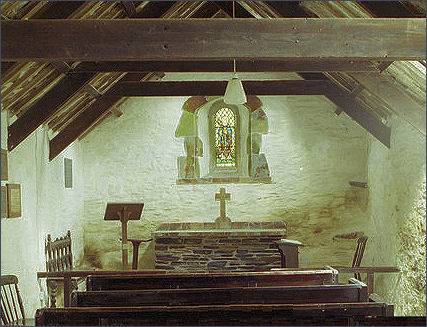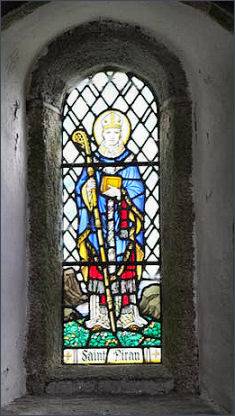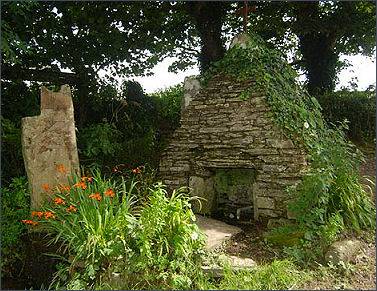Trethevy
OS Grid ref:- SX 076 893
 The small, historic North Cornish hamlet of Trethevy straddles the B3263 road and is situated between the villages of Tintagel and Boscastle. The name is thought to derive from the Cornish Tredhewy meaning Dewi's Farm.
The small, historic North Cornish hamlet of Trethevy straddles the B3263 road and is situated between the villages of Tintagel and Boscastle. The name is thought to derive from the Cornish Tredhewy meaning Dewi's Farm.
Trethevy has a number of historic buildings and is an early Christian site. To the north-west lies Rocky Valley, a place of stunning rugged scenery. The valley has been carved out of the rock by the Trevillet River (In Cornish Duwy, meaning dark river) . At their highest point, the slate walls of the valley tower spectacularly over seventy feet above the river below.
 Medieval St Piran's Chapel (pictured left) stands at the centre of Trethevy, the earliest recorded mention of the chapel is in 1457. The building has rough white-washed walls under the crude timber roof. A small lancet window with a trefoil head is situated in the east wall and what appears to be a rough stone shelf or piscina is on the south side. On the north wall there is also a more recent stained glass window
representing Saint Piran, (right) who is depicted standing in the Rocky Valley.
Medieval St Piran's Chapel (pictured left) stands at the centre of Trethevy, the earliest recorded mention of the chapel is in 1457. The building has rough white-washed walls under the crude timber roof. A small lancet window with a trefoil head is situated in the east wall and what appears to be a rough stone shelf or piscina is on the south side. On the north wall there is also a more recent stained glass window
representing Saint Piran, (right) who is depicted standing in the Rocky Valley.
Until the early twentieth century a massive stone altar slab stood in the chapel and the centuries old old arched oak door frame of the south door could still to be seen, it has since been built up, but its position is still discenable. A stone coffin was discovered in July 1944 by Father Edward Arundell, the vicar of Tintagel. The body was buried with its feet towards the west, suggesting that it may have been that of a priest. A granite Norman lamp was on display until its was stolen from the chapel in 1993.
 The holy well of Saint Piran (pictured left) stands at the side of an ancient lane that runs beside the Rocky Valley Hotel. It is built over with a mid twentieth century slate beehive and is topped with an iron cross. It is believed by some that the hermitage of St. Nectan was beside a waterfall, St. Nectan's Kieve, in St Nectan's Glen. St. Nectan was a hermit who gave his name to the glen, he is supposed to have lived above the falls and is reputed to be buried nearby.
The holy well of Saint Piran (pictured left) stands at the side of an ancient lane that runs beside the Rocky Valley Hotel. It is built over with a mid twentieth century slate beehive and is topped with an iron cross. It is believed by some that the hermitage of St. Nectan was beside a waterfall, St. Nectan's Kieve, in St Nectan's Glen. St. Nectan was a hermit who gave his name to the glen, he is supposed to have lived above the falls and is reputed to be buried nearby.
An inscribed granite pillar, dating from Roman times stands at the roadside by St. Piran's, said to have once been a monastery and now a private residence. The inscription on the stone reads C DOMI N GALLO ET VOLUS - 'For the Emperor Caesars our lords Gallus and Volusian.' Trebonianus Gallus and Antoninianus Volusianus reigned in the years 251-253 AD. The pillar lends weight to the importance of the nearby trading post of Tintagel where merchants from as far away as the Mediterranean came to trade with the Cornish for their tin. St Piran's was claimed by former Vicar and historian, A. C. Canner, to have been the site of an early monastic settlement dating from the sixth century AD: in its present form it dates from the mid sixteenth century with medieval origins.
Further upstream from Saint Nectan's Glen stand the remains of a longhouse, Tregenver, which may possibly date from the fourteenth century. The house was inhabited by farm labourers until the late nineteenth century. It is probable that Tregenver (or Genver) can be identified with the manor of Tregrebri as recorded in the Domesday Survey.
Trethevy Manor was built in the twelfth century and was the home of the Wade family who were Trethevy's principal residents until the twentieth century. The Wades were prosperous farmers and many of them served as mayors of the Borough of Bossiney of whom the best known is William Wade.